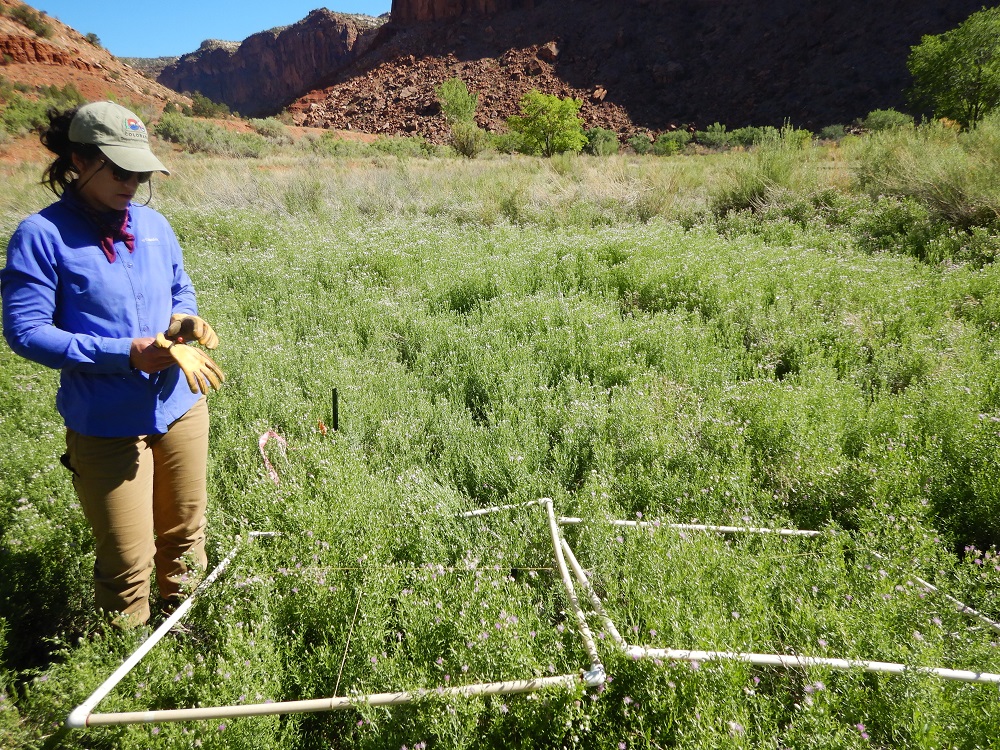
By Sonya Daly, Dan Bean and Melanie Mollack of the Colorado Department of Agriculture, Conservation Services, Biological Control Program.
Russian knapweed (Rhaponticum repens) is a nonnative weed in the western United States. It was introduced in the late 1800’s and is now invading and degrading cropland, rangeland, riparian areas, and roadsides.
This deep-rooted perennial is persistent and difficult and expensive to control by conventional means, is toxic to horses and outcompetes native vegetation by producing chemicals that inhibit plant growth. Russian knapweed is listed by the State of Colorado as a noxious weed, to be suppressed, contained, or locally extirpated.
Biocontrol agents
The Colorado Department of Agriculture (CDA) offers biocontrol agents to help suppress weeds and insect pests. When two gall-forming agents were developed and tested by CABI, and became available for use against Russian knapweed, the CDA was prepared to use them against the more than 50,000 hectares of the weed that currently infests Colorado (See Fig 1 above).
The CDA’s biocontrol program, located in western Colorado at the Palisade Insectary, first received the gall midge (Jaapiella ivannikovi) in 2009 and the stem gall wasp (Aulacidea acroptilonica) in 2013 from the United States Department of Agriculture Animal and Plant Health Inspection Service (USDA APHIS) who had initially received them from CABI (See Fig 2 below).

The gall midge and stem gall wasp can decrease flowering and stunt plant growth. Both agents cause galling (abnormal plant growth) after laying eggs on the plant. The gall midges lay eggs on the shoot tips and feeding larvae stimulate newly forming leaves to remain closed, forming rosette galls on main and lateral shoots. The gall wasps lay eggs in the stems of the plant, stimulating abnormal swelling along the main or lateral stems as larvae tap into nutrients within the stems.
Gall flies released
In 2012 we first released the gall flies (J. ivannikovi) at a disturbed site near the Dolores River where a major Russian knapweed infestation covered more than 24 hectares in a high-value riparian corridor (Figure 1). Along with releasing the gall fly we set up monitoring transects and a 16 m2 grid, centered at the release point, to measure the impact of the biocontrol agents on the target weed and desired native plants.
Over the next eight years, we detected a low but consistent presence of rosette galls at the site with no signs of overall plant suppression. After releasing stem gall wasps (Aulacidea acroptilonica) in 2019 we detected a steady increase within the census area centered on the release site and a stunting of plant growth as the galls substantially impacted plant structure (Figure 3).

The density of stem galls peaked in 2021, with over 3,300 galls per m2, followed by a decline in density in 2022, most likely due to stunted plants presenting fewer potential oviposition sites for the wasps to use to generate galls. An intriguing pattern was also noted in which the midge gall density increased substantially after the introduction of the wasps.
Short and tender regrowth
Plants heavily infested with stem galls generate short and tender regrowth that proved attractive to oviposition by the rosette gall midges. Not only were there increased numbers of galls but the size was notable, with some plants having galls resembling fingerling potatoes.
In 2022 the census area around the point of release had 74% of Russian knapweed plants galled (72% by the wasp and 2% by the midge). We observed an increase of both agents on same stem on plants (Figure 3). We noted decreased flower production and plant height which may be enhanced by an interaction of both galling agents on same plant.
We will continue to monitor the Dolores River site as well as others across Colorado as it appears the Russian knapweed galling agents may play a key role in suppression of the weed in the western US.
Dr Dan Bean, Program Manager, Palisade Insectary, said, “The CDA is very grateful for the foundational work and dedication by the scientists at CABI, without which we would have no safe effective biocontrol agents to use against this highly damaging weed.”
Related News & Blogs
Biological control in action: Zambia’s field days on fighting fall armyworm
Experts from CABI recently held two field days and an expo in Zambia, showcasing innovative approaches to pest management to 584 farmers, agro-dealers and other stakeholders to help raise awareness of approaches to tackle the invasive fall armyworm (Sp…
11 June 2025




